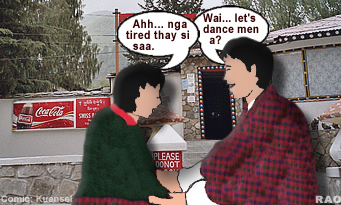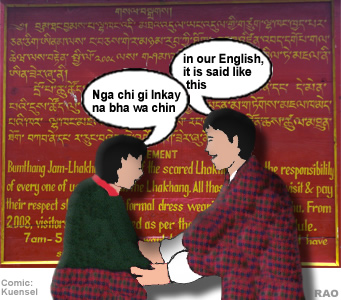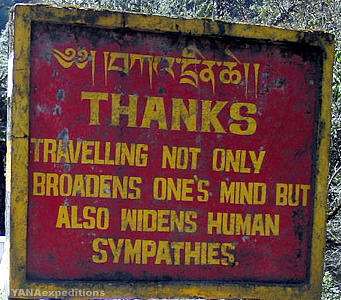|
Dzongkha:
Bhutan's national language
|
 |
Bhutan's
Culture: Dzongkha |
|
 |
Bhutan Information |
|
|
 |
|
Mixing
languages
|
 |
Dzongkha,
the national language, is the preferred spoken language but English dominated
as the language for reading and writing among Bhutanese high school students
and educators according to a study by a non-formal educator.
 |
"Students
and educators shy away from reading and writing Dzongkha," said the joint
director of non-formal and higher education, Singye Namgyel who presented
a paper titled "Linguistic choices in a multilingual society: a case
of Bhutanese high school students and educators domains of language use",
during the Xth Himalayan language Symposium in Thimphu.
|
|
The
socio-linguist speculates insufficient exposure in terms of materials for
reading and instruction, and the difficult nature of reading and writing
Dzongkha script for its lack of popularity as a written language. "Ninety
percent of the respondents wrote and read in English as they found it 'comfortable,"
the survey report stated.
The
survey was carried out using a questionnaire, semi-structured interviews
and participant observations on linguist choice in five domains; family,
friendship, work/school, religion and recreation.
 |
|
The
survey noted four languages; English, Dzongkha, Sharchop, Nepali and Hindi
were dominantly used. For example,
a high school student spoke in his or her mother tongue at home with family
and spoke English with the teachers, Dzongkha or a mix of different languages
among friends, and preferred watching Hindi programmes on television.
Singye
Namgyel says the study also revealed that there was a decline in the use
of mother tongue especially among the minority languages. They include the
Brokkat, Lakha, Bokha, Chalikha, Dzalakha, Monpa Olekha among 15 such dialects which remained confined to grandparents. The maximum spoke Dzongkha,
estimated at 160,000 people.
|
|
Dzongkha
and English were also used as a language of formal forum, Dzongkha as a
lingua franca and English as a matrix language, a language of science,
technology and international communication and a source of pressure on
local language and culture, the study said. "This may be telling that they
mixed or switched between these two languages in which they felt more comfortable,
or when they lack the vocabulary to express better," Singye Namgyel's study
paper stated.
In
the survey, the respondents had reported that they used English more than
Dzongkha when expressing views, talking to teachers which was seemingly
influenced by the medium of instruction in the schools.
 |
|
TA
comment of the study report read, "90 percent of the language that I
use during work/school hours is English embedded with Dzongkha and Sharchop".
A lot of 'mixing' and 'switching' was also noticed between dominant languages
like Dzongkha and English in the work and school domain. "These library
books, dato sarp yoe" (these library books are still new) was an example
of mixing languages as recorded by the report.
Such
mixing was a trend among the qualified, the lesser educated like peons
and drivers more frequently used only Dzongkha.
|
|
The
study further states that while Dzongkha
was a dominant language in religion and recreation domain, Nepali was the
language of transportation where most public transport drivers spoke Nepali
and Hindi was the preferred language of media and entertainment. Respondents
listened to news on radio in English but preferred Dzongkha songs while
Hindi dominated television programmes.
Another
aspect reported by the study was the mixture of language used especially
among friends. A respondent wrote "when I have problem in expressing things
in one language, I use different languages like Dzongkha, Sharchop, English,
Kurtoep and Nepali depending on the language that my friend is most comfortable
with." "It implies that language use is whichever came handy since there
existed no barrier in the use of languages," according to Singye Namgyel.
"The
findings not only inform the language policy makers and language planners
but can also build a clear ground for curriculum developers, as language
policy is a learning policy," says Singye Namgyel. "Such an understanding
is more important and useful in a multilingual society as Bhutan."
 |
| Contributed
by
Bishal Rai, KUENSEL, Bhutan's National Newspaper, 2004 |
| Information on Bhutan |
 |
| Links |
 |
 |
 |
External
Links |
|







